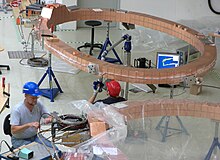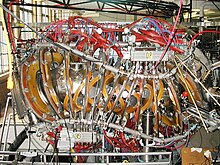
Back ستيلاراتور Arabic Стелларатор Bashkir Стеларатор Bulgarian Stellarator Catalan Stelarátor Czech Stellarator German Stellarator Spanish Stellaraator Estonian Estelaratore Basque استلراتور Persian



A stellarator is a device that confines plasma using external magnets. Scientists researching magnetic confinement fusion aim to use stellarator devices as a vessel for nuclear fusion reactions. The name refers to stars as fusion also occurs in stars such as the Sun.[1] It is one of the earliest fusion power devices, along with the z-pinch and magnetic mirror.
The stellarator was invented by American scientist Lyman Spitzer of Princeton University in 1951, and much of its early development was carried out by his team at what became the Princeton Plasma Physics Laboratory (PPPL). Lyman's Model A began operation in 1953 and demonstrated plasma confinement. Larger models followed, but these demonstrated poor performance, losing plasma at rates far worse than theoretical predictions. By the early 1960s, any hope of quickly producing a commercial machine faded, and attention turned to studying the fundamental theory of high-energy plasmas. By the mid-1960s, Spitzer was convinced that the stellarator was matching the Bohm diffusion rate, which suggested it would never be a practical fusion device.
The release of information on the USSR's tokamak design in 1968 indicated a leap in performance. After great debate within the US industry, PPPL converted the Model C stellarator to the Symmetrical Tokamak (ST) as a way to confirm or deny these results. ST confirmed them, and large-scale work on the stellarator concept ended in the US as the tokamak got most of the attention for the next two decades. Research on the design continued in Germany and Japan, where several new designs were built.
The tokamak ultimately proved to have similar problems to the stellarators, but for different reasons. Since the 1990s, the stellarator design has seen renewed interest.[2] New methods of construction have increased the quality and power of the magnetic fields, improving performance.[3] A number of new devices have been built to test these concepts. Major examples include Wendelstein 7-X in Germany, the Helically Symmetric Experiment (HSX) in the US, and the Large Helical Device in Japan.
- ^ Clery, D. (2015). "The bizarre reactor that might save nuclear fusion". Science. doi:10.1126/science.aad4746.
- ^ Clery, D. (17 January 2013). "After ITER, Many Other Obstacles for Fusion Power". Science.
- ^ Gates, David A. Stellarator Research Opportunities: A Report of the National Stellarator Coordinating Committee. OCLC 1187827940.
© MMXXIII Rich X Search. We shall prevail. All rights reserved. Rich X Search